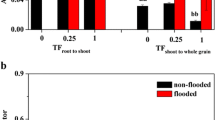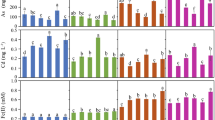Abstract
Soil heavy metal pollution, especially lead (Pb) and arsenic (As), is a global issue that requires urgent attention. In the present study, phosphate-modified ferric-based material (PFM) was used to remedy Pb and As co-contaminated soil. The remediation potential of PFM on Pb and As co-contaminated soil was studied by static culture experiments, and the effect on maize (Zea mays L.) seedling growth was studied using pot experiments. The results showed that the bioavailability of Pb and As in the soil and their accumulation in the seedlings were reduced when PFM was added to the soil. At 2–6 wt% PFM, the remediation rates of Pb and As reached 57%–82% and 62%–76%, respectively, and their accumulation in the seedlings decreased by 27.8%–68% and 55.6%–70%. The optimal amount of PFM was 4 wt% of the soil. There was a linear correlation between the amount of DTPA-extractable Pb or NaHCO3-extractable As in the soil and the amount of Pb or As accumulated by the seedlings. The correlation coefficients of Pb and As reached 0.7690–0.8166 and 0.9982–0.9779. Seedling growth was also promoted. Compared with the controls, the seedling emergence rate increased by 1.4%–4%, plant height increased by 4.1%–12.4%, plant weight increased by 29.6%–37%, and the root length increased by 5%–52%. In summary, PFM offers an environmentally friendly approach with excellent potential for the remediation of Pb and As co-contaminated soil.









Similar content being viewed by others
References
Bao SD (2004) Analysis of soil physicochemical properties, 3rd edn. China agriculture press, BeiJing (in Chinese)
Chen R (2010) Study on the preparation, species and coagulation performance of polymeric phosphate ferric sulfate flocculants. ChongQing University, ChongQing, China, Dissertation (in Chinese)
GB15618–2018 (2018) Soil environmental quality risk control standard for soil contamination of agricultural land (in Chinese)
GB/T23739–2009 (2009) Soil quality—analysis of available Pb and cadmium contents in soils atomic absorption spectrometry (in Chinese)
Guo GH, Lei M, Chen TB, Yang JX (2018) Valuation of different amendments and foliar fertilizer for immobilization of heavy metals in contaminated soils. J Soils Sediments 18(1):239–247
Gypser S, Hirsch F, Schleicher AM, Freese D (2018) Impact of crystalline and amorphous iron- and aluminum hydroxides on mechanisms of phosphate adsorption and desorption. J Environ Sci 70:175–189
Hao LL, Liu MZ, Wang NN, Li GJ (2018) A critical review on arsenic removal from water using iron-based adsorbents. RSC Adv 8:39545–39560
HJ/T 166–2004 (2004) Technical specifications for soil environmental monitoring (in Chinese)
Kim J, Kim YS, Hyun S, Moon DH, Chang JY (2016) Influence of an iron-rich amendment on chemical lability and plant (Raphanus sativus L.) availability of two metallic elements (as and Pb) on mine-impacted agricultural soils. Environ Sci Pollut R 23(20):20739–20748
Kuo CC, Moon KA, Wang SL, Silbergeld E, Navas-Acien A (2017) The association of arsenic metabolism with cancer, cardiovascular disease, and diabetes: a systematic review of the epidemiological evidence. Environ Health Perspect 125(8):087001
Li SL, Wang W, Liang FP, Zhang WX (2017) Heavy metal removal using nanoscale zero-valent iron (nZVI): theory and application. J Hazard Mater 322:163–171
Liao Q, Tu GY, Yang ZH, Wang HY, He LX, Tang JQ, Yang WC (2019) Simultaneous adsorption of as(III), cd(II) and Pb(II) by hybrid bio-nanocomposites of nano hydroxy ferric phosphate and hydroxy ferric sulfate particles coating on aspergillus Niger. Chemosphere 223:551–559
Libralato G, Devoti AC, Zanella M, Sabbioni E, Mičetić I, Manodori L, Pigozzo A, Manenti S, Groppi F, Ghirardini AV (2016) Phytotoxicity of ionic, micro- and nano-sized iron in three plant species. Ecotox Environ Safe 123:81–88
Liu BL, Ai SW, Zhang WY, Huang DJ, Zhang YM (2017) Assessment of the bioavailability, bioaccessibility and transfer of heavy metals in the soil-grain-human systems near a mining and smelting area in NW China. Sci Total Environ 609:822–829
Liu MH (2011) Coagulants and coagulation technology. Chemical industry press, Beijing (in Chinese)
Lwin CS, Seo BH, Kim HU, Owens G, Kim KR (2018) Application of soil amendments to contaminated soils for heavy metal immobilization and improved soil quality—a critical review. J Soil Sci Plant Nutr 64:156–167
MEP (Ministry of Environmental Protection), MLR (Ministry of Land and Resources) (2014) Bulletin of survey on national soil pollution of China. BeiJing, China (in Chinese)
Nejad ZD, Jung MC, Kim KH (2018) Remediation of soils contaminated with heavy metals with an emphasis on immobilization technology. Environ Geochem Hlth 40(3):927–953
Nur T, Loganathan P, Ahmed MB, Johir MAH, Nguyen TV, Vigneswaran S (2019) Removing arsenic from water by coprecipitation with iron: effect of arsenic and iron concentrations and adsorbent incorporation. Chemosphere 226:431–438
Rehman M, Rehman W, Waseem M, Hussain S, Haq S, Rehman MA (2019) Adsorption mechanism of Pb2+ ions by Fe3O4, SnO2, and TiO2 nanoparticles. Environ Sci Pollut R 26(19):19968–19981
Rizwan M, Ali S, Rehman MZ, Javed MR (2018) Lead toxicity in cereals and its management strategies: a critical review. Water Air Soil Pollut 229:21
Siddiqui SI, Chaudhry SA (2017) Iron oxide and its modified forms as an adsorbent for arsenic removal: a comprehensive recent advancement. Process Saf Environ 111:592–626
Tessier A (1979) Sequential extraction procedure for the speciation of particulate trace metals. Anal Chem 51(7):844–851
Tian L, Liang YZ, Lu Y, Peng LF, Wu PX, Shi ZQ (2018) Pb(II) and cu(II) adsorption and desorption kinetics on ferrihydrite with different morphologies. Soil Sci Soc Am J 82(1):96–105
Timlin DJ, Naidu TCM, Fleisher DH, Reddy VR (2017) Quantitative effects of phosphorus on maize canopy photosynthesis and biomass. Crop Sci 57(6):3156–3169
Wang C, CuiY ZJH, Gomez M, Wang SF, JiaYF (2018) Occurrence state of co-existing arsenate and nickel ions at the ferrihydrite-water interface: mechanisms of surface complexation and surface precipitation via ATR-IR spectroscopy. Chemosphere 206:33–42
Wenzel WW, Kirchbaumer N, Prohaska T, Stingeder G, Lombi E, CAdriano D (2001) As fractionation in soils using an improved sequential extraction procedure. Anal Chim Acta 436(2):309–323
Woolson EA, Axley JH, Kearney PC (1971) Correlation between available soil arsenic, estimated by six methods, and response of corn (Zea mays L.). Soil Sci Soc Am J 35(1):101–105
Yang ZH, Liu L, Chai LY, Liao YP, Yao WB, Xiao RY (2015) Arsenic immobilization in the contaminated soil using poorly-crystalline Fe-oxyhydroxy sulfate. Environ Sci Pollut R 22(16):12624–12632
Yuan YN, Chai LY, Yang ZH, Wu RP, Liu H, Liang LF, Shi W (2017a) Immobilization of cd and Pb in soils by polymeric hydroxyl ferric phosphate. Trans Nonferrous Metals Soc China 27:1165–1171
Yuan YN, Chai LY, Yang ZH, Yang WC (2017b) Simultaneous immobilization of lead, cadmium, and arsenic in combined contaminated soil with iron hydroxyl phosphate. J Soils Sediments 17:432–439
Zeng GM, Wan J, Huan DL, Hu L, Huang C, Cheng M, Xue WJ, Gong XM, Wang RZ, Jiang DN (2017) Precipitation, adsorption and rhizosphere effect: the mechanisms for phosphate-induced Pb immobilization in soils—a review. J Hazard Mater 339:354–367
Zhang M, Dai M, Xia L, Song SX (2017) Comparison of arsenic adsorption on goethite and amorphous ferric oxyhydroxide in water. Water Air Soil Pollut 228:427
Funding
The authors gratefully acknowledge the financial support of China’s Ministry of Agriculture, China’s Ministry of Finance and the Leading Group Office of pilot projects for farmland soil heavy metal pollution remediation and crops planting structure adjustment in Chang-Zhu-Tan, Hunan province (Agricultural Finance Letter No. 6 in 2016). They also acknowledge the financial support of the Natural Science Foundation of Hunan province, China (2019JJ70034), and the financial support of Science and Technology Planning Project of Hunan Province, China (2014SK3192).
Author information
Authors and Affiliations
Corresponding authors
Additional information
Responsible editor: Elena Maestri
Publisher’s note
Springer Nature remains neutral with regard to jurisdictional claims in published maps and institutional affiliations.
Rights and permissions
About this article
Cite this article
Yuan, Y., Lu, M., Tu, N. et al. Phosphate-modified ferric-based material remediates lead and arsenic co-contaminated soil and enhances maize seedling growth. Environ Sci Pollut Res 27, 7234–7243 (2020). https://doi.org/10.1007/s11356-019-07356-4
Received:
Accepted:
Published:
Issue Date:
DOI: https://doi.org/10.1007/s11356-019-07356-4




